PowerliftingTechnique.com is independent and supported by our readers. We may earn a commission if you buy through the links below. For more, see our disclosures page.
Over the past decade, strongman competitions have continued to rise in popularity. You’ve probably seen huge guys lifting the Atlas Stone or pulling an airplane.
While many people have no interest in competing, you can still incorporate strongman training into your program.
So, what is the best strongman program? I chose the best here:
- Powerlifting Technique’s Strongman Program: Best for Beginners
- The Darkhorse Program by Brian Alsruhue: Best for Improved Work Capacity
- The Juggernaut Method 2.0 by Chad Wesley Smith: Best for Athletes
- The Cube Method by Brandon Lilly: Best for Intermediate Lifters
- 5/3/1 by Jim Wendler: Best for Simplicity
- Westside Barbell by Louie Simmons: Best for Advanced Lifters
Not having the right program could waste months or years of your training, so be sure to read the full post. Through years of training, as well as coaching a variety of athletes, I have sought the best knowledge available to be able to lay out an effective strongman training program.
In this article, I’ll discuss:
- The benefits of Strongman training
- Important lifts for Strongman
- How to program Strongman training
- The best Strongman training programs
- A short history of Strongman
- What Strongman is
3 Benefits of Strongman Training
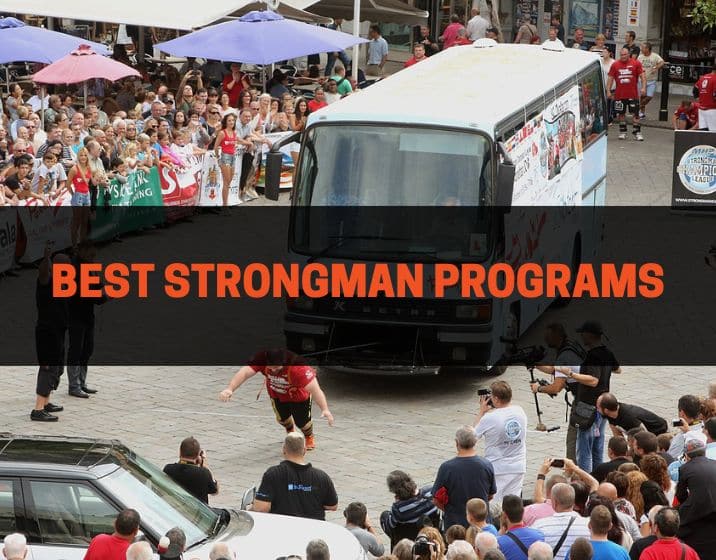
1. Functional Strength Increases
All resistance training will strengthen you if you are pushing yourself and your program is well thought out. Strongman can provide even more increases in strength compared to more traditional weight training.
Strongman incorporates many unconventional lifts, which can accelerate progress, especially when incorporating them for the first time. For example, pulling a bus uses compound and functional movements with a heavy load. You’re working your lower and upper body all in one.
Another benefit to overall strength development is that there isn’t too much emphasis on any one lift. Powerlifting can also make you strong, but too much focus can be given to the three power lifts at the expense of everything else.
Strongman encourages you to be strong in a variety of movements.
2. Variety and Fun
Since strongman allows for a lot more variety than other strength sports, it is less likely that you will become bored by your training.
In your training, you must stick with certain movements long enough to get good at them, but if a lift begins to stall or become boring, there are many others to work on that will still improve performance in strongman.
Strongman also requires that you are maximally strong, strong for 60-90 seconds, and very explosive. Being able to focus on the development of many qualities makes training fun.
3. Improved Athletic Performance
Many of the movements in Strongman will improve athletic performance as a whole. Several events in Strongman involve rapid triple extension (extension of the hips, knees, and ankles), a key ability to master to be a good athlete.
Many events also require moving with heavy loads. The top strongmen competitors are amazingly light on their feet, considering many are 6 ‘3 or taller and nearly 400 lbs. Someone with a smaller frame will likely develop the ability to move even more quickly.
I also made a video about my strongman program. Check it out below or on YouTube.
What are the most important lifts for Strongman?
Several lifts are extremely important for Strongman. These lifts include:
- The deadlift
- The overhead press
- The squat
- Yoke
- Farmer carry
- Atlas Stones
Strongman requires mastery of many movements. If you are a competitive Strongman, the most important thing is to practice the events that will be used in your next competition. This can be difficult, however, because events are usually only made known up to a few months in advance.
You may find yourself between contests, months out from a competition with unknown events, or maybe you’re not interested in competing. In this case, which events are the most important to master?
The Deadlift
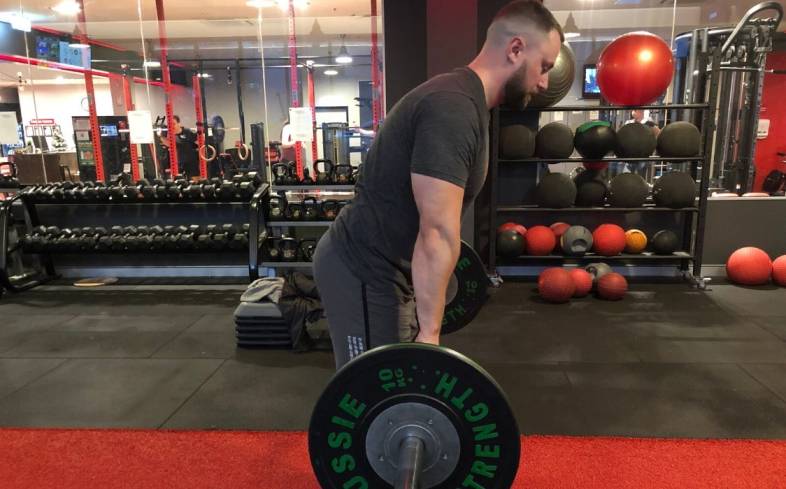
The deadlift is a major staple in strongman competitions and should be a major focus of any strongman training program. While training the deadlift on a standard bar will go a long way, it is important to be strong at several variations of the deadlift.
Common variations used in the competition include the standard barbell deadlift, the axle bar deadlift, the tire deadlift, and the silver dollar deadlift. You may not have access to all of these implements, but becoming proficient in several variations, beginning with the barbell deadlift, will greatly benefit you in competition.
The Overhead Press
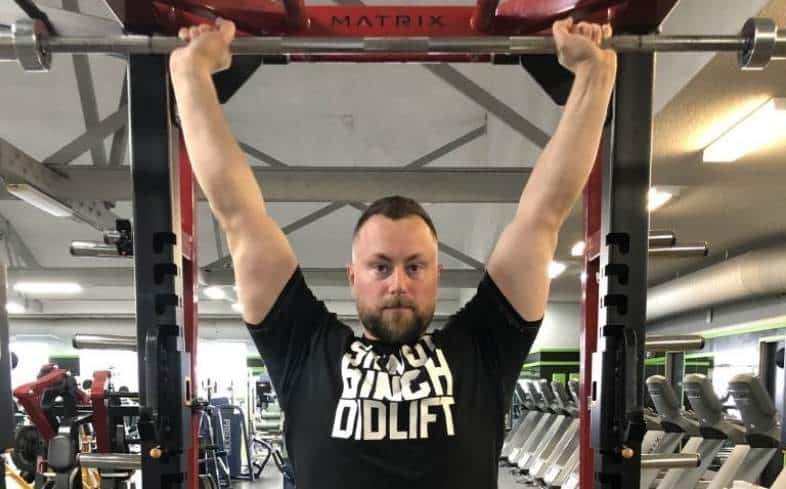
Overhead pressing strength is a must for anyone hoping to be successful in strongman. Not only are variations of the overhead important to master as a competitor, but overhead pressing is a tremendous way to develop size and strength in the upper body, specifically the shoulders.
Similar to the deadlift, several common variations of overhead press might be included in a strongman competition. These variations may include the log press, the axle bar press, the circus dumbbell press, the Viking press, etc.
Building overhead strength in several overhead pressing variations will help you be prepared for competition, even if you are required to perform a variation that you haven’t before.
The Squat
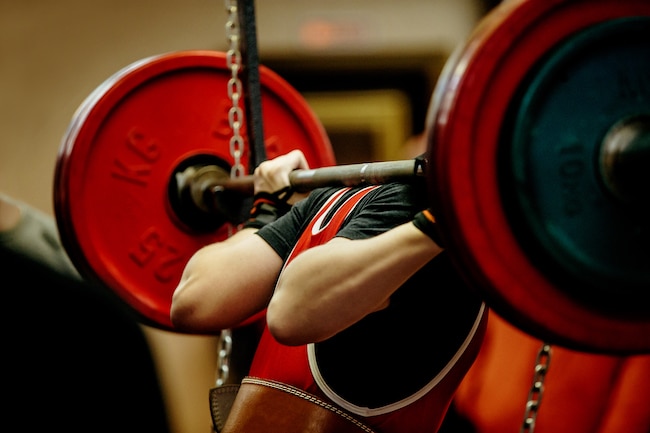
While squatting events in strongman competitions are fairly rare, the squat is one of the best ways to build strength in the lower body. Variations of the squat will build tremendous strength in the quads, glutes, and upper back. Being strong in these areas is vital for many events in Strongman.
Since the squat likely won’t be a competition event, you can choose from many different variations depending on your own preferences and where you think your weaknesses are.
Some great variations to choose from are the back squat, the front squat, the safety bar squat, the belt squat, the Zercher squat, etc. Be mindful of which variation you choose.
If you are a strong squatter already, you may want to stay away from the back squat, as it will require greater loads and be more fatiguing than other variations.
The Yoke
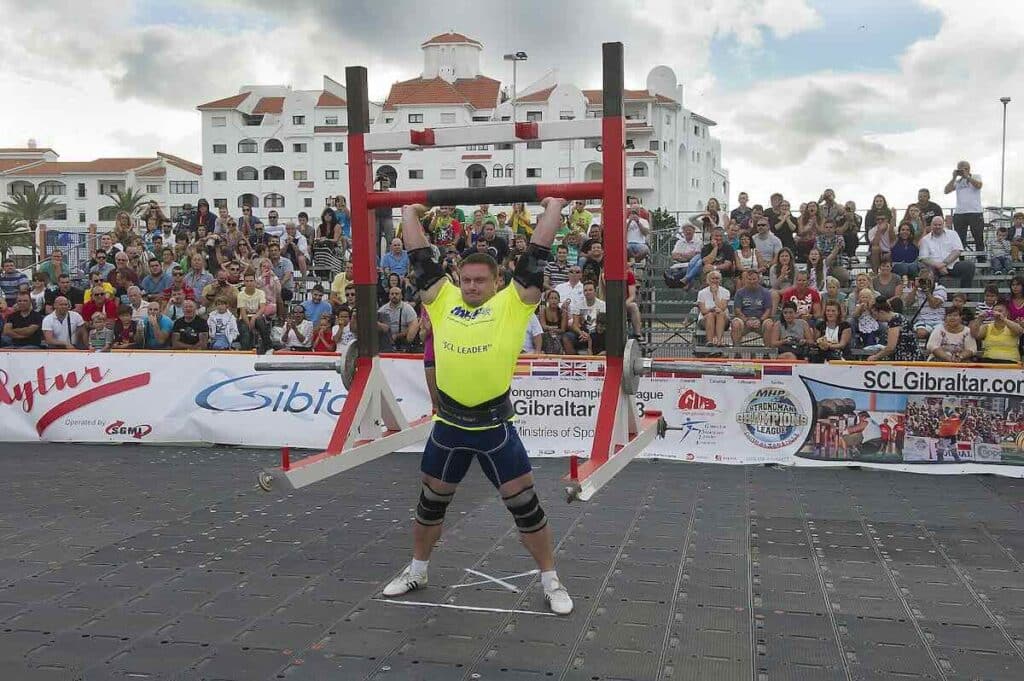
The yoke carry is a common event in Strongman. It involves lifting and carrying a heavy yoke frame over a specified distance or for a set period of time. The yoke typically consists of a horizontal crossbar on the upper back with two upright posts. The upright posts have pegs that allow plates to be added.
The yoke may not be an event at your competition, but getting good at it will help you with most moving events. Placing tremendous loads on your back and walking with it, often well above what you can squat, causes major adaptations to the body.
Your lower body and core strength will improve significantly. You will likely see an improvement in your static lifts due to an improvement in core strength and the ability to brace the core.
The Farmer Carry
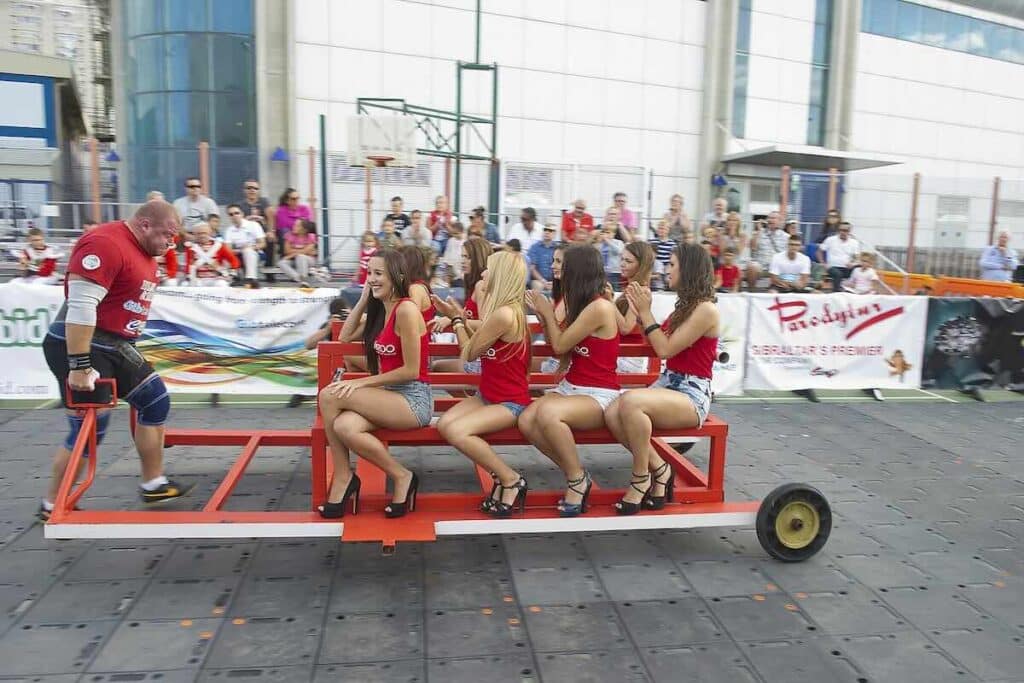
If you plan to compete in Strongman, there will almost certainly be a carry event in your competition. Even if you don’t compete, various carries are some of the best things you can do in training to carry over to regular life.
Carries help you develop tremendous grip and lower body strength and will light up your back and traps. Most of the top-level Strongman have huge traps, largely due to how good they are and how often they train carrying events.
Ideally, you would train the farmer carry using farmer handles or a frame. However, the great thing about carries is that various equipment can be used. If you are in a commercial gym, one of the easiest ways to perform heavy carries is to use a trap bar, but dumbbells can also be used.
Atlas Stones
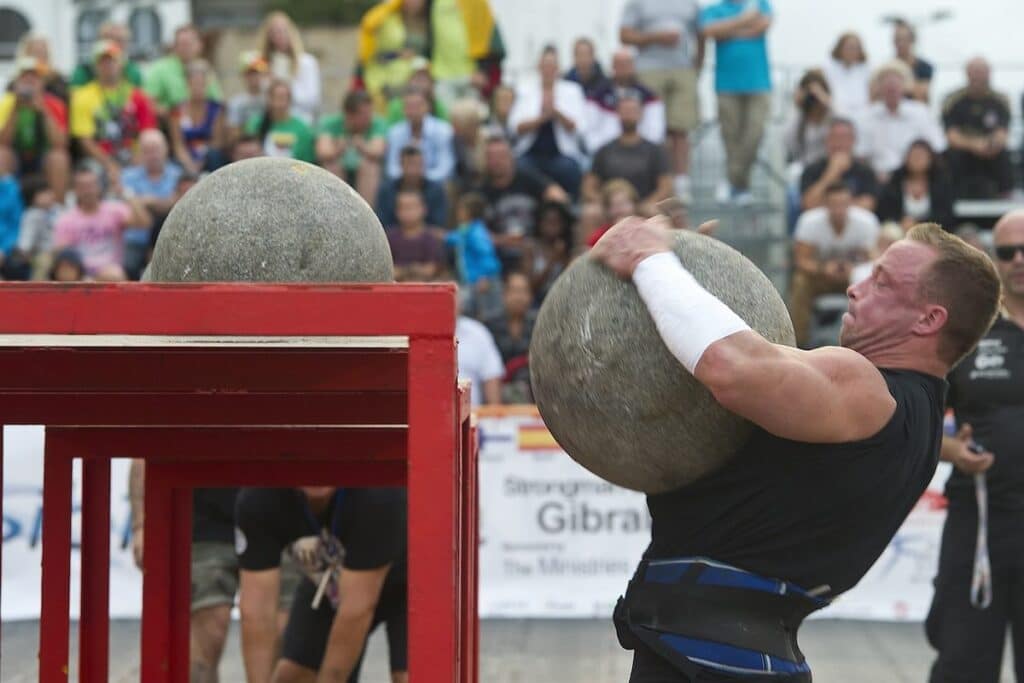
People often ask me if I compete in Strongman, and one of their first questions is, “are they the ones that lift the big boulders?” Even people with little understanding of the sport know that atlas stones are a fixture in the sport of Strongman.
Atlas stones require strength in the lower body and tremendous strength in the mid and upper body to squeeze the stone into the body as you lift it off the ground and into your lap.
They also require an explosive triple extension to get the stone up onto a platform or over a bar. Even if you participate in a contest that does not involve atlas stones, getting stronger at stones will improve your ability to lift other odd objects that may be part of the competition.
Check out this article to learn if you can combine CrossFit and powerlifting training.
How to Program Strongman Training
In this section, I will talk about how I have often organized my own Strongman training and how I encourage other athletes to do it as well. In my time as an athlete and a coach, my understanding of training has continued to evolve.
Still, several books have influenced how I program for Strongman, especially in the beginning phases of training Strongman.
These books are:
- A Thoughtful Pursuit of Strength by Chad Wesley Smith
- Tactical Strongman: The Complete Guide by Josh Bryant and Adam Benshea
Over time, I have tried to adapt what I’ve learned from them and other great strongman coaches and competitors, including several programs I mentioned in this article. There are many moving parts when it comes to organizing strongman training.
To keep it simple, we will train some variations of each of the most important strongman movements listed above during the week. Those movements are the deadlift, the overhead press, the squat, the yoke, the farmer carry, and the atlas stones.
A program that includes these movements will get you good at about 80% of what Strongman requires. The rest will come when you learn and practice the specific events used at your competition.
Strongman requires being maximally strong, explosive, and good for reps or distance. Using the deadlift as an example, one week, the deadlift will be trained light and fast. One week, it will be trained with moderate weights, and one week, it will be trained heavy before deloading and repeating. The same goes for the main pressing movements and each of the movements on the event day.
Check out this article if you need help structuring your powerlifting training.
The 6 Best Strongman Programs
1. Powerlifting Technique’s Strongman Program: Best for Beginners
Rating: 4.5/5
Pros
- Focuses on key movements in Strongman
- Details on how to load different events
- Utilizes heavy, medium, and light training days
- Can be used with all experience levels of lifters
- Opportunities to test strength at heavy and light loads
Cons
- Only focuses on a few strongman events. Other events would need to be substituted based on the upcoming competition.
This program is great for those who want to improve some of the most important strongman movements. Getting strong at these movements will prepare you for most strongman contests. It will also improve your maximum strength, explosiveness, and endurance in each event. See the sample 4-week program below, which is inspired by my own program.
About the Program
Day 1: Deadlift & Squat
Day 1 will be deadlift-focused, followed by the squat and some accessories. Week 1 will be heavy or high, week 2 will be medium, and week 3 will be light or low. (Important to note that light or low doesn’t mean easy; it is just lighter than the other days).
| Day 1 | ||||||||
|---|---|---|---|---|---|---|---|---|
| Exercise | Week 1 (high) | Week 2 (med) | Week 3 (low) | Week 4 (deload) | ||||
| Deadlift | 4 x 3 @ 85-90% or work up to 3RM, 2 x 3 @ 90% of 3RM | 4 x 6 @70-75% | 6 x 2 @ 60% w/ 30 sec rest between sets, 1 AMRAP set after | 3 x 5 @ 60% | ||||
| Front Squat | 4 x 3 @ 80-85% | 3 x 6 @ 65-70% | 8 x 3 @ 60% w/ 30 sec rest between sets | 3 x 5 @ 55% | ||||
| Back Extension | 3 x 15 | 3 x 12 | 3 x 10 | 2 x 10 | ||||
| Hanging Knee Raises | 3 x 10 | 3 x 10 | 3 x 10 | 2 x 10 | ||||
*The deadlift can be swapped for other variations (axle bar deadlift, silver dollar deadlift, etc.)
**Other squatting variations can be used as well (safety bar squat, back squat, belt squat, etc.)
Day 2: Overhead Press
Day 2 will be an overhead pressing-focused day, followed by another press and some accessories. Week 1 will be light or low, week 2 will be heavy, and week 3 will be medium.
| Day 2 | ||||||||
|---|---|---|---|---|---|---|---|---|
| Exercise | Week 1 (low) | Week 2 (high) | Week 3 (medium) | Week 4 (deload) | ||||
| Axle Bar Overhead Press | 6 x 2 @ 60% w/ 30 sec rest between sets, 1 AMRAP set after | 4 x 3 @ 85-90% or work up to 3RM, 3 x 3 @ 90% of 3RM | 4 x 6 @ 70-75% | 3 x 5 @ 60% | ||||
| Closegrip bench | 3 x 8 @ 60% | 4 x 3 @ 80-85% | 3 x 6 @ 65-70% | 3 x 5 @ 55% | ||||
| Pull ups/lat pull down | 4 x 12 | 4 x 10 | 4 x 10 | 3 x 10 | ||||
| DB overhead tricep extension | 3 x 12 | 3 x 10 | 3 x 10 | 2 x 10 | ||||
| Dumbbell hammer curl | 3 x 12 | 3 x 10 | 3 x 10 | 2 x 10 | ||||
*Axle bar can be substituted for other overhead movements, if you have access to a log, use it here.
**Another flat bench variation can also be chosen. Close grip is a great general movement for the chest, shoulders, and triceps.
Day 3: Event Training
Day 3 will be reserved for event training. One week, one event will be trained heavy, another medium, and another light. The following week, the events will rotate.
| Day 3 | ||||||||
|---|---|---|---|---|---|---|---|---|
| Exercise | Week 1 | Week 2 | Week 3 | Week 4 (deload) | ||||
| Yoke | 10 sec runs. Start light add weight until failing to go 50’ in 10 seconds | Moderate weight, max distance in 1 minute | Work up to 3 heavy sets of 50’ | none | ||||
| Farmer Walk | Moderate weight, max distance in 1 minute | Work up to 3 heavy sets of 50’ | 10 sec runs. Start light add weight until failing to go 50’ in 10 seconds | 50% of top weight from week 2 for 1 set of 50’ | ||||
| Atlas Stones | Work up to heavy set of 3 using 5’ platform or bar | Light weight, 10 x 2 w/ 30 sec rest using 5’ platform or bar | Light stone using 5’ platform of bar, max reps in 1 minute | 3 x 3 w/ light stone | ||||
| Optional lower leg work/hip flexor work | 3 x 15 ea. | 3 x 12 ea. | 3 x 10 ea. | 2 x 10 ea. | ||||
*These 3 movements are great foundational movements for strongman. If you know the events for your contest, do 3 of them on this day. Your deadlift and overhead events would be trained on other days in the week.
Day 4: Secondary Presses
Day 4 will be a secondary pressing day used to build strength in the chest, shoulders, and triceps for overhead events. Week 1 will be medium, week 2 will be light or low, and week 3 will be heavy or high.
| Day 4 | ||||||||
|---|---|---|---|---|---|---|---|---|
| Exercise | Week 1 (med) | Week 2 (low) | Week 3 (high) | Week 4 (deload) | ||||
| Incline Bench | 4 x 6 @ 70-75% | 8 x 3 @ 60% w/30-sec rest between sets | 4 x 3 @ 85-90, or work up to 3RM, 3 x 3 @ 90% of 3RM | 3 x % @ 60% | ||||
| Dips | 4 x 6-8 (add weight) | 4 x 10 body weight or w/ band | 4 x 3-4 (heavy) | 2 x 5 | ||||
| Single Arm Dumbbell Row | 4 x 12 | 4 x 10 | 4 x 10 | 3 x 10 | ||||
| Dumbbell Skull Crusher | 3 x 15 | 3 x 12 | 3 x 10 | 2 x 10 | ||||
| Barbell Curl | 3 x 15 | 3 x 12 | 3 x 10 | 2 x 10 | ||||
| Rear Delt Work | 3 x 15 | 3 x 12 | 3 x 10 | 2 x 10 | ||||
*Other pressing movements can be used instead of incline and dips. I have always seen good carry-over from incline to overhead, but other movements would also be great. This would be a good day for dumbbell pressing work.
**Off-day training: doing some form of aerobic work on off days is a good idea. This can be done on a bike in the form of tempo training. Peddle for 20-30 seconds, at about 70% effort, for 2 sets of 6 reps. You can also perform 20-30 minutes of steady-state cardio.
This is a great way to organize your training. If you want to continue from here, you can run this program again or up the intensity. If you choose to up the intensity, then there are some small changes you can make:
- Your high days will go up to 90-95% for sets of 2, or up to a 2 RM with back-off sets of 2.
- Your medium days will go up to 75-80% for sets of 5.
- Your low days will go up to 65% with the same sets, reps, and rest times.
- The event day will stay the same except for working up to a heavy set of 2 on Atlas stones in week 1.
View this post on Instagram
2. The Darkhorse Program by Brian Alsruhue: Best for Improved Work Capacity
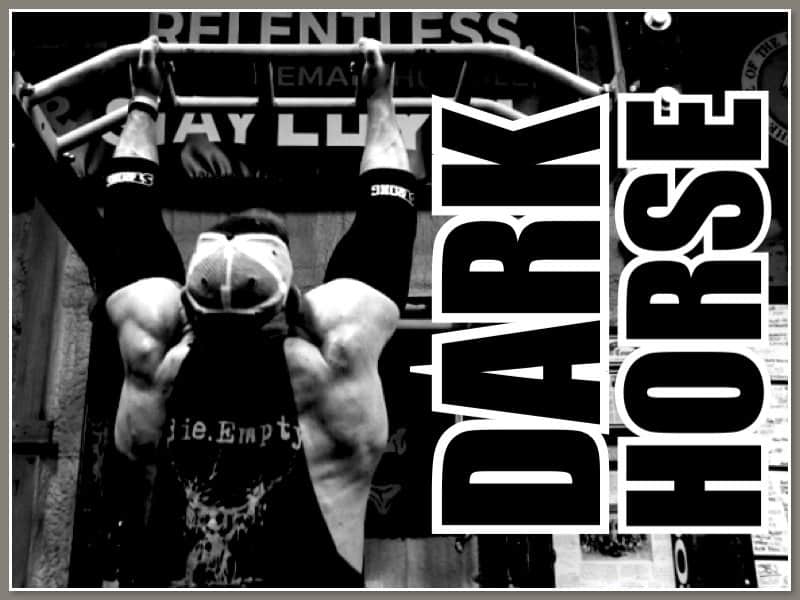
Rating: 4.5/5
Pros
- All of Alsruhue’s programs include strongman training options
- Focusing on giant sets
- The program will help with your conditioning
- Great price and Alsruhue provides a full breakdown on his YouTube channel
Cons
- May be difficult for those without adequate conditioning
About the Program
Brian Alsruhue is a successful strongman competitor and coach. He has put out countless hours of strongman-related content. If something might happen in Strongman, Brian probably has a video about it.
He also frequently releases training programs online. These programs are available for purchase, but Alsruhue also fully describes the program on his YouTube channel.
The Darkhorse program focuses on the deadlift, squat, overhead press, and bench. All of Alsruhue’s programs include many options regarding how to include strongman-specific events.
Alrsuhue’s programs' key component is his emphasis on giant sets. People often perform supersets in the gym, meaning they go back and forth between two movements. Brian uses giant sets, meaning you’ll sometimes do as many as 4 or 5 movements back to back. This is a great way to build up conditioning.
The Darkhorse program is a great option for those who need to get their conditioning up. The program allows for strongman training events to be used as conditioning. Utilizing giant sets during your main lifts will also greatly benefit your conditioning.
3. The Juggernaut Method 2.0 by Chad Wesley Smith: Best for Athletes
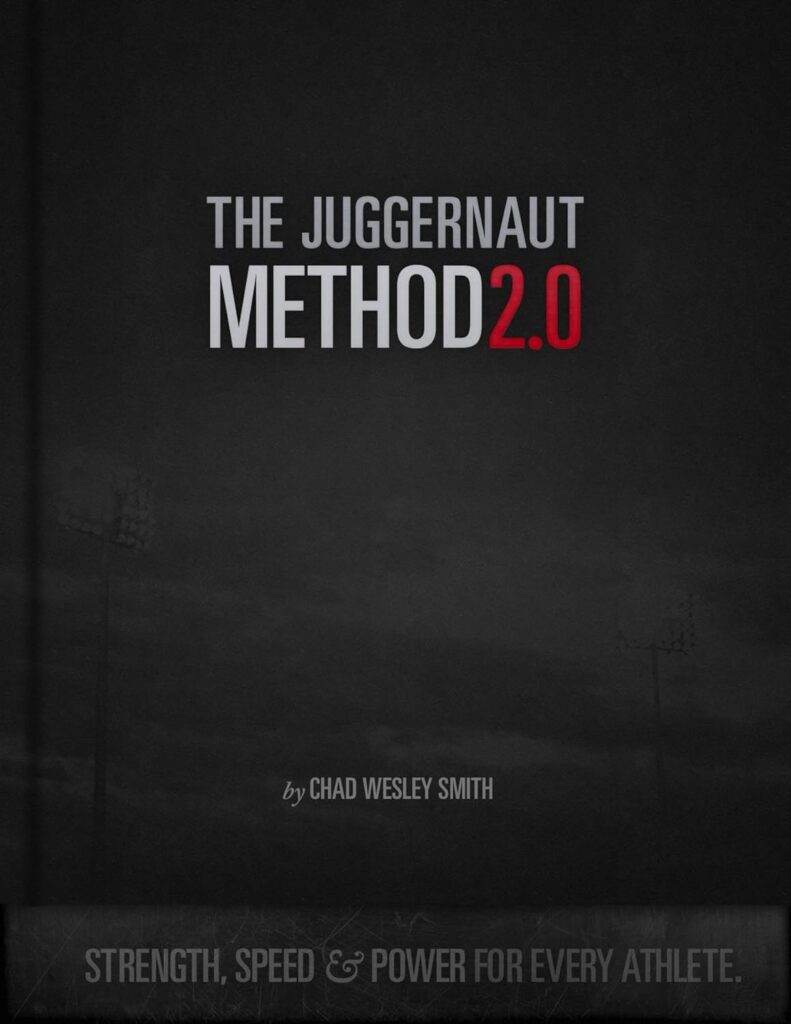
Rating: 4/5
Pros
- Has distinct phases focusing on lighter, moderate, and heavy loads
- Focuses on building the squat, bench, deadlift, and overhead press
- Book includes a short section on how to adapt the program to strongman
- Program focuses on submaximal high-volume training compared to many other well-known training programs
Cons
- Program was not necessarily developed specifically for strongman
About the Program
Juggernaut Training Systems, founded by Chad Wesley Smith, has become well-known in strength and conditioning. Most people familiar with this company connect it with powerlifting and the athletes and content they put out regarding improving and programming the squat, bench, and deadlift.
However, this company originally started as sports performance coaching for various field/court sports. The Juggernaut Method 2.0 is a book I read early on in my coaching career and was a major influence on things I did with my athletes and clients.
Not only does it talk about lifting, but it also discusses how to program sprints, throws, and jumps, which many strongmen and powerlifters could benefit from. While not specifically written for strongman, there is a section on how to use it for your base programming and then add strongman training.
The program is sixteen weeks, with distinct phases built in.
- The first four weeks focus on sets of 10 with the main lifts, with the first week being an accumulation phase, meaning the weight is lighter, and multiple sets of 10 are performed.
- In week 2, the percentages increase, and fewer total sets are performed, known as intensification.
- The last week is a realization phase where you perform an AMRAP (as many reps as possible) on your main lifts with instructions on changing your max based on how many reps you achieve.
This program is great for those who have strongman goals, as it specifies how to add strongman training into your training. It also shares important information on including sprints, jumps, and throws, which many strength athletes would benefit from.
4. The Cube Method by Brandon Lilly: Best for Intermediate Lifters
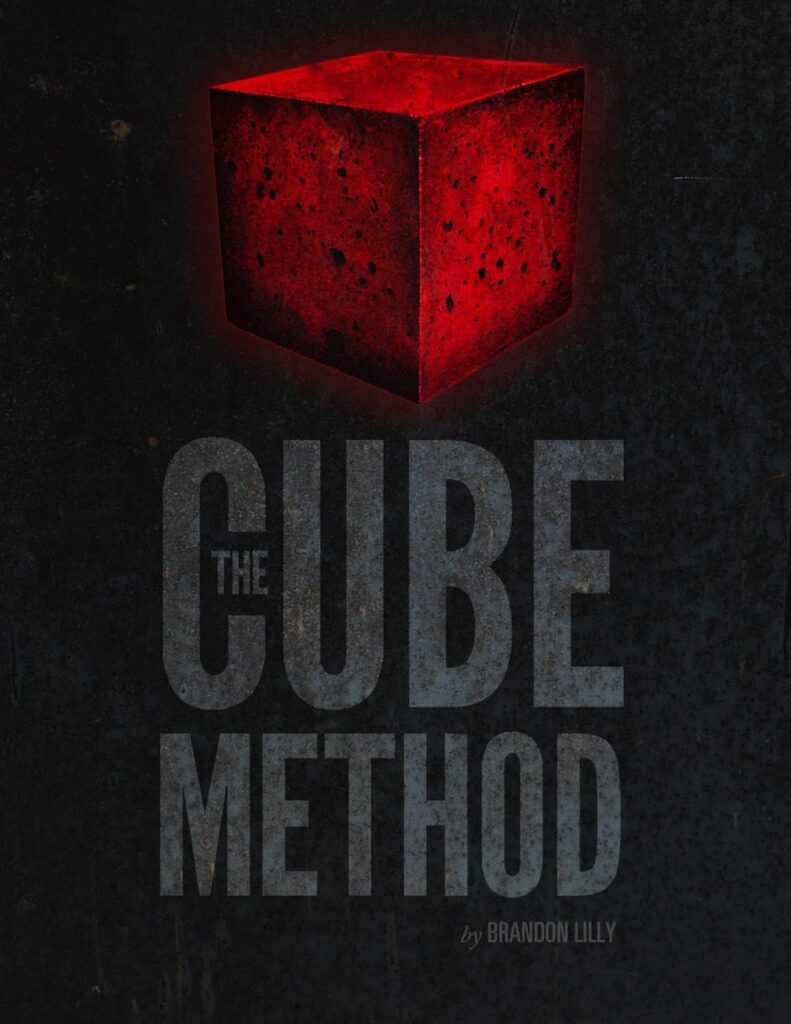
Rating: 4/5
Pros
- Focuses on heavy, explosive, and repetition work throughout the program
- Features several distinct phases with increasing percentages in each phase
- Focuses on building strength in the squat, bench, and deadlift
- Allows for recovery between training sessions
Cons
- Was created for powerlifting, however, it can be adapted for strongman
About the Program
Brandon Lilly is one of the best powerlifters of all time. He competed in raw, single-ply, and multi-ply and totaled elite in 5 weight classes. The Cube Method is the conglomeration of everything he learned through a long powerlifting career.
In the Cube Method, the squat, bench, and deadlift will be trained during a week of training. One of those movements will be trained heavy, one will be performed focusing on speed, and one will be trained for high reps. The fourth day is an upper body accessory day, where Lilly recommends training the overhead press, back, and calves.
After three weeks, there will be a deload week, and then in the following training block, the percentages for the heavy, explosive, and repetition days will increase. The percentages will increase again in the third training block.
While the program focuses on the squat, bench, and deadlift as the primary movements, these can easily be switched out for other lifts. There is also a lot of freedom within the program regarding accessory work.
This program is great for intermediate lifters and up. Beginners may benefit from more frequency in some main movements to get them down. Beginners may also need more attention given to their pressing strength. Intermediate and advanced can benefit from focusing on strength, explosiveness, and repetition work.
5. 5/3/1 by Jim Wendler: Best for Simplicity
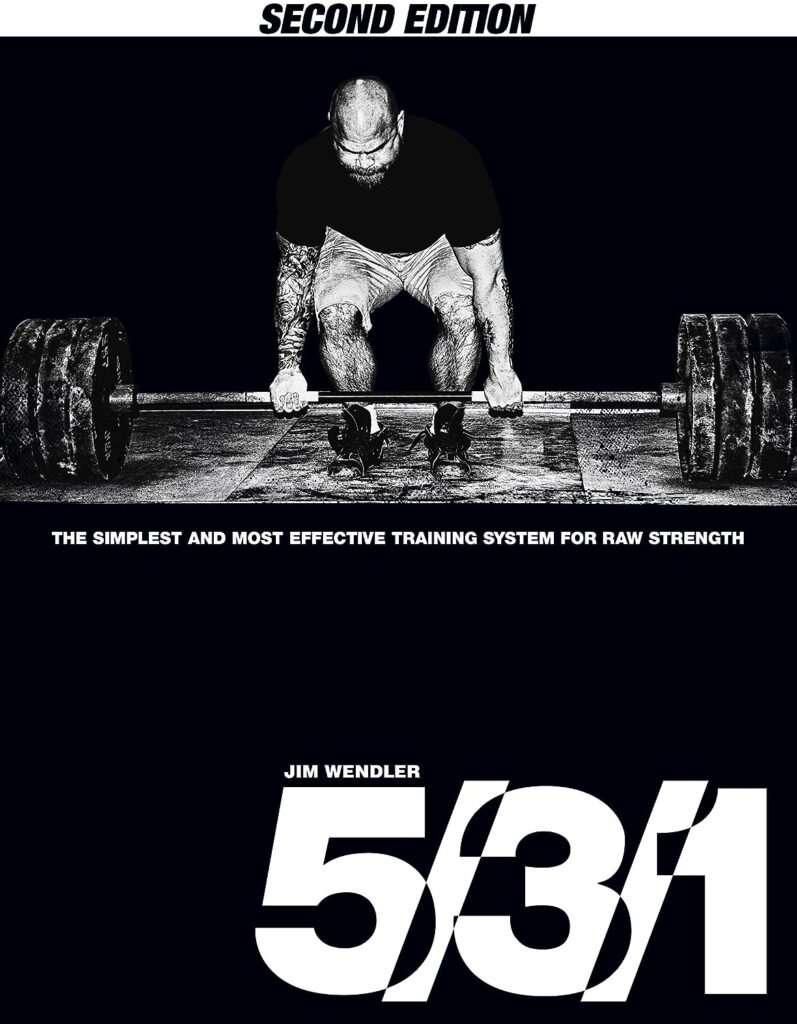
Rating: 4/5
Pros
- One of the most utilized programs of all time.
- Emphasis on the building squat, bench, deadlift, and overhead press.
- Allows plenty of opportunities to set personal records.
- Easy to follow.
Cons
- Primarily used for powerlifting and general strength development.
- Some consider the original 5/3/1 program to be too low volume.
About the Program
5/3/1 is one of the most well-known training programs for a reason, and that’s because it works. It focuses on the basics and emphasizes long-term progress. The program focuses on the squat, deadlift, bench press, and overhead press.
Before beginning the program, it is important to establish conservative maxes for each main movement. Wendler usually recommends 85-90% of your actual one rep max. The main lifts break down as follows:
- Week 1: 3 sets of 5 reps at 65%, 75%, and 85% (or more) for an AMRAP (As Many Reps As Possible) set of your training max. The last set is always a plus set to try and set a rep PR.
- Week 2: 3 sets of 3 reps at 70%, 80%, and 90% (or more).
- Week 3: 1 set of 5 reps at 75%, 1 set of 3 reps at 85%, and 1 set of 1 rep at 95% (or more).
- Week 4: A “deload” week, where you use lighter weights for higher reps to allow for recovery and adaptation.
In addition to the main lifts, you can include assistance exercises to target specific muscle groups or weaknesses. Wendler recommends keeping assistance work relatively simple and focusing on exercises like chin-ups, dips, rows, and lunges. Assistance work can be adjusted especially if strongman is the main training goal.
5/3/1 is a great program because it is so simple. At this point, Jim Wendler has multiple 5/3/1 books available and countless articles, videos, etc., written about how to run it and the results you can see. It’s a straightforward way to get stronger.
6. Westside Barbell by Louie Simmons: Best for Advanced Lifters
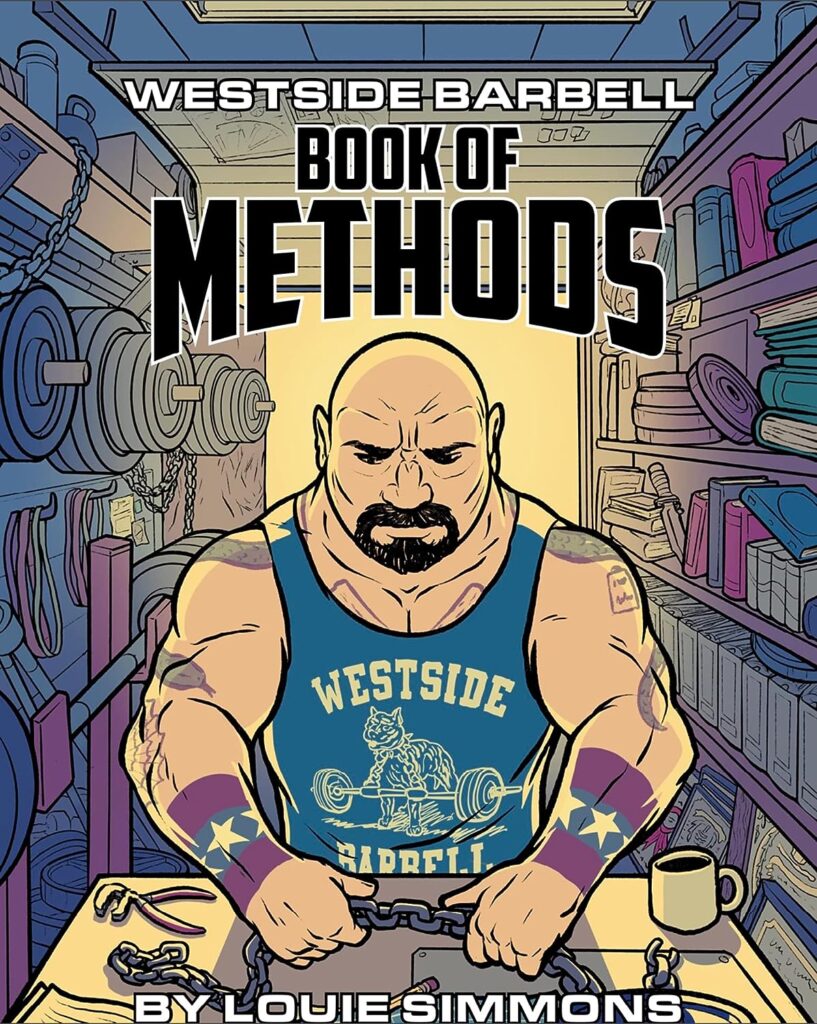
Rating: 4/5
Pros
- Great for experienced lifters
- Addresses individual weak points for
- Uses max effort and dynamic effort training days
Cons
- Can be very complex.
About the Program
Westside Barbell and their training methods are some of the most well-known around the world. Methods implemented by Louie Simmons led to the development of some of the strongest lifters ever.
West Barbell is an advanced powerlifting program that incorporates the conjugate method, meaning that it focuses on improving multiple qualities at the same time.
Typically, this program will feature two max effort days, one upper body and one lower body. It also includes two dynamic effort days, one upper and one lower. The primary lift on max effort days is trained at near maximum, and the main lifts on dynamic days are trained very explosively.
An effective conjugate program requires a lifter to know which max effort lifts will be best to help improve their strength in the competition movements. It also requires one to be in tune with one's body to know what needs to be focused on most in one's assistance work.
This program specifically was developed for powerlifting but can be adapted to any goal. This program is best for advanced lifters because it requires the experience to know which exercises are best to be used as max efforts exercises and how to bring up weaknesses through accessory work.
Short History of Strongman
Feats of strength have existed in all times and in all civilizations, with some dating back thousands of years. For that reason, many consider strongman to be the oldest strength sport. However, the modern strongman is generally believed to have laid its roots in the late 1800s and early 1900s.
Modern strongman started at a time when events like circuses were extremely popular. Strongmen were paid to travel to different shows and perform at many venues. Strongmen were brought to these shows to entertain people by performing various odd lifts. Over time, the sport became more organized and more standard events were created.
What is Strongman?
The name Strongman is a little deceiving. It involves much more than simply lifting heavy things. There are often both explosive and endurance components to many of the events. Strongman also often requires the athlete to move with heavy loads.
In a strongman contest, there typically are 5 different events. Taking first in one of these events gives you the most points, followed by second, and so on. At the end of the 5 events, the points are tallied, and a winner is declared.
While events differ contest to contest, generally speaking, there will be some kind of deadlift event, some kind of overhead press event, some type of carrying or moving event, some type of loading event, and some type of pushing or pulling event.
Check out this article to learn about the difference between powerlifting and Strongman.
Frequently Asked Questions
How many days a week do strongmen train?
Many things can affect how many days per week a strongman trains, including experience, ability to recover, programming style, etc. Generally speaking, most strongmen strength train at least 4 times per week. Training this many days allows for adequate attention to be given to the deadlift, overhead press, and strongman events.
What is the most important muscle for strongmen?
Strongman requires that you are well-balanced and strong in all major muscle groups. That being said, the back muscles are especially important (the latissimus dorsi, and erector spinae muscles). Many events require picking things up from the ground, which requires these muscles to be strong.
Do strongmen need cardio?
Yes, strongmen need cardio. The aerobic system fuels long-duration exercise. While the longest events in Strongman are only 60-90 seconds, it is important to train the aerobic system. The aerobic system helps to recover between events and between training sessions.
Conclusion
It can be difficult to find a strongman program that covers all the necessary training components.
A strongman program should focus on building the deadlift, overhead press, yoke, farmer carry, and atlas stones. Doing this will provide you with a solid foundation, and you can begin to train other events when preparing for a specific contest.
All of these programs can be very beneficial. For those getting into strongman for the first time, The Darkhorse Program by Brian Alsruhue is a great way to build strength and conditioning and can be a great way to get into strongman events.
The Juggernaut Method 2.0 is also a great program to learn how to incorporate strongman training and sprints, jumps, and throws into your training.
Training strongman is fun and extremely beneficial for strength and athleticism. Don’t put off training this way any longer. Time to get after it!
Check out this article for a list of great online workout programs.
About The Author
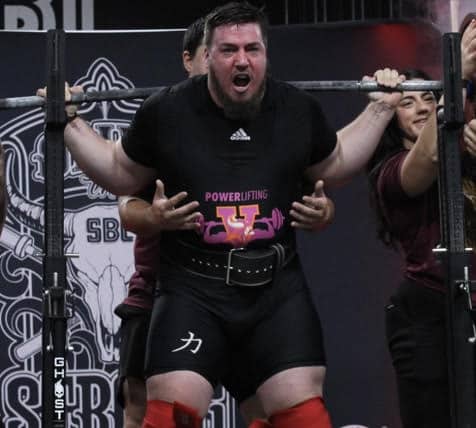
Derek Reasch is a strength and conditioning coach with experience coaching at the Division I, Division II, and NAIA levels. Previously, he worked as a certified personal trainer and nutrition coach. He holds a Master’s in Kinesiology and a Bachelor’s in Exercise Science. As a competitive powerlifter, he has achieved an elite total in several weight classes. He currently is focused on his online coaching and apparel business, Reaschmode Athletics.

